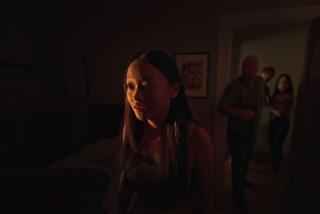Modern ‘Gothic’ Tale Takes Confusing Turns
- Share via
“My name is Beckett, and this is not a dream. This is not a delusion. This is not based on a true story. This is true. Doesn’t anyone believe me?”
This desperate introduction opens “Innocence,” Jane Mendelsohn’s follow-up to the much-acclaimed “I Was Amelia Earhart.” It is not an easy time for Beckett Warner, the flawed narrator of “Innocence.” She is on the verge of puberty. Her mother has recently died, and her father has chosen this moment to move the family back to New York City and enroll his daughter in a “fancy school.”
“Great heroines have dead mothers,” Beckett observes. Indeed, so many wonderful novels--from Austen’s “Emma” on--have started from this kind of premise. But “Innocence,” billed by its publisher as “a modern gothic coming-of-age story,” finds its literary antecedents elsewhere--in the land of the celluloid. “Buffy the Vampire Slayer,” “Heathers,” “Scream 1, 2 and 3,” even “The Faculty,” seem to have made their way into the pages of this novel, in which an idea with literary possibilities is more like a bad voice-over.
Soon after Beckett’s arrival in New York, three popular and pretty classmates are found dead in an apparent suicide pact. Then Beckett’s father begins dating Pamela, the school nurse. Pamela suggests Beckett see a doctor to cope with her burgeoning adolescence and its accompanying sense of imminent doom. The doctor gives Beckett some small, brightly colored pills.
Suddenly, we begin to notice the uncertainty of the tale and the unreliability of its narrator. Is Beckett dreaming, or isn’t she? Is the doctor purposely drugging her, or is Beckett inventing things to justify her own drug use? Her stories take on a more sinister tone, and increasingly morbid scenarios begin to take over. Is Beckett’s obsession with blood just an adolescent way of coping with menarche, or is her subconscious warning her of real danger? Is Pamela, we begin to wonder, a crazed killer, a vampire even, who thirsts for the blood of virgins? Is her book group truly a coven, their tea cups filled with human blood?
Or is all of this just the product of a youthful imagination? One of the major problems with “Innocence” is the fact that none of these questions is ever resolved, and the story ends with the same indecisiveness with which it began. Part of this is due to the fact that Beckett is a rather capricious narrator who overstates the obvious one moment and then engages in subterfuge the next. So much of her language sounds as if it were the rote fulfillment of an English teacher’s assignment--”hair [that] swung like rope,” “my hair snaked over his face like seaweed,” “[t]he look in her eyes . . . was the placid dead look of a mannequin” or, alternately, “the look on her face was dead like the look of the sky before it erupts into lightning”--that there is little joy in reading through the 52 staccato, stream-of-consciousness chapters that constitute “Innocence.”
Mendelsohn creates little here to hold the reader’s interest, let alone imagination. As told by Beckett, this blurring of fact and fiction, the cold hard glare of reality with the intoxicating dreamscape of fantasy reaches a sort of crescendo and then seems to dissipate, even disintegrate, into little more than disturbing, misleading imagery.
The idea for “Innocence” began when Mendelsohn was asked to write a treatment for a horror movie. “Innocence” will, inevitably, return to that genre. Joe Lieberman, beware; according to Riverhead, the book has already been optioned for the screen, by the aptly named Killer Films.
More to Read
Sign up for our Book Club newsletter
Get the latest news, events and more from the Los Angeles Times Book Club, and help us get L.A. reading and talking.
You may occasionally receive promotional content from the Los Angeles Times.










